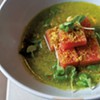Published April 1, 2009 at 4:32 a.m.
The door creaks, and two well-dressed servers swoop in. The first holds a bottle of effervescent water. The second bears a platter topped with thin slices of lemon, layered like the scales on a fish. With a pair of tongs, he inserts a fragrant round into each freshly filled glass. They exit, closing the heavy, arched door behind them.
I’m left alone in the wine cellar with my suit-jacketed husband, the murmuring fizz of the San Pellegrino and the flickering light of several candles, perched on ledges that jut from a stone wall. The opposite wall features a mural of a mostly nude, Rubenesque woman reclining on an al fresco chaise lounge, holding a bunch of grapes. Her expression is mildly lascivious. Behind each of us, hundreds of wine bottles rest on numbered racks in neat rows. “It doesn’t feel like we’re in Vermont any more,” I say.
In fact, our cozy retreat — featuring a single, white-linen-draped table and piped-in Sinatra tunes — can be found at the Pitcher Inn in Warren. The town of 1700 is nestled at the base of Sugarbush Mountain and just minutes from the Mad River Valley ski area. Despite its proximity to the mountains, and the fact that every room comes with a locker for storing outdoor gear, the sumptuous property is not your average ski-bum getaway.
For one, the Pitcher is the only Vermont inn that has the honor of membership in the international Relais & Chateaux network. According to General Manager Ari Sadri, each of the 475 member hotels across 55 countries “must maintain a benchmark of comfort, service and cuisine,” as well as excelling in intangibles such as “the warmth of the welcome and the uniqueness of the accommodations.” Here, said accommodations go for $425 to $800 per night. While Vermont boasts a smattering of places that serve high-end food, few of them offer a truly luxurious all-around experience. Folks in the know say The Pitcher Inn is one of them.
Dining à deux in a wine cellar is certainly unique. Each evening, one lucky party of two to six guests can reserve the single table and spend the evening sampling the chef’s five-course tasting dinner, accompanied by wines from the 13,500-bottle collection ($100 per person plus alcohol, tax and gratuity). Sadri, who acts as one of the inn’s two sommeliers along with David Sullivan, believes this assemblage sets the inn apart, though it isn’t the state’s largest. Of his purchasing philosophy, he says: “I used to be guided by the wine press, until I realized that I didn’t actually agree with what it said, and decided to go with my own palate.”
Knowing my own knowledge of vino to be lacking, I ask Sadri to select wines by the glass to accompany each course, and he seems pleased to oblige. “People who aren’t going in on a whole bottle should be able to find something interesting by the glass,” he says. He rotates numerous offerings on and off of the “glass list,” he adds, believing it “should be a reflection of the larger wine list instead of a place that bad wines go to die.”
Sadri starts by pouring a glass of nonvintage Gaston-Chiquet Brut. Although the inn’s selection includes Champagne from the most celebrated producers, he thinks small vineyards often turn out superior sparklers. In general, Sadri likes to “spend a lot more time promoting small producers of unique and character-full wines.” Since that can lead to surprises both pleasant and unpleasant, the inn allows guests to return any bottle for any reason, no questions asked.
“I’m concerned that people’s wine tastes aren’t quirky enough,” Sadri explains. “Our hope is that people will experiment because it’s safe to do so here.”
The Gaston-Chiquet smells pleasantly yeasty and boasts light floral flavors. As I sip, our servers, who’ve introduced themselves as Mark and Mason, deliver an amuse-bouche — a tidbit designed to whet diners’ appetites. We sample a single mahogany clam each, presented in a puddle of black bean sauce with a small pile of refreshing Asian slaw on the side.
Then come the appetizers proper. The first is an oozing slab of foie gras over parsnip puree, served on a plate laced with balsamic and strewn with cubes of vanilla-poached apple. The second is a portion of handmade butternut-squash-and-taleggio ravioli in browned butter, topped with Marcona almond slivers and served with a scoop of Greek yogurt so rich it’s reminiscent of mascarpone. Although the foie gras is sumptuousness incarnate, the pasta has such a perfect balance of nutty, sweet and saline flavors that it’s hard to choose one over the other.
As Mark unobtrusively clears the plates, we chat about his background. Like many of the other staffers, he’s worked at The Pitcher Inn for more than a decade. Mason came on board just a year after Mark. Sadri, who worked his way up over the years, began in 1997. Executive Chef Sue Schickler — one of a mere handful of female head chefs in the state — has been there just as long.
When Schickler came to The Pitcher Inn, she already had years of experience. She graduated from culinary school at Johnson & Wales “a long time ago,” she admits, but credits “two great chefs” from Annapolis and Delaware as her strongest influences.
Schickler describes the fare on the menu, which changes constantly, as “new American” in a general sense, but says she embraces global influences when they work with the “local, seasonal ingredients” she uses in the kitchen. “There’s no niche we’re stuck in,” she maintains. “If something Asian catches our eye, we’ll do that.”
Case in point: Of our entrées, one brings to mind the breezy southern coast of France, while the other conjures images of dense German forests. And, while the flavors are entirely different, each is delightful.
In the Mediterranean entrée, featuring striped bass and clams with capers, Niçoise olives, roasted tomatoes and tournéed potatoes (shaped like footballs), every element is cooked to perfection. Same with the Teutonic dish, a seared venison loin sprinkled with just the right amount of salt and served over mustard spaetzle with braised cabbage and a buttery red-wine-prune sauce.
The cellar is soundproof, but we can hear patrons chatting it up at the nearby Tracks lounge whenever Mark and Mason slip in to refill our water glasses or bring a new course. While some visitors shell out between $28 and $34 for the inn’s à la carte entrées, others opt to sample casual fare at the bar.
Like the dinner menu, the much smaller selection at Tracks features global bites, from fish ’n’ chips with tartar sauce to Thai shrimp curry with apple chutney (both $14). Hungry guests fresh from the slopes can also munch a down-home American buttermilk-biscuit-topped chicken pot pie ($14) or a burger with “shallot-dusted” French fries ($12) — a far cry from our tasting menu.
The food is not the only thing about the inn that’s eclectic. After the original building burned to the ground in 1993, Yale-educated architect David Sellers was hired to build a new structure with an authentic look and feel. Says Sadri: “The challenge was to put up a new hotel in an old location, and not have it look like it landed from outer space.”
Sellers chose to evoke three different traditions in the inn’s exterior: colonial stylings over the building’s original footprint, Victorian for a second portion and a more contemporary style for a third. In addition, he introduced intentional flaws — random steps, winding hallways and odd angles — to mimic the imperfections that can result when buildings receive additions over time. “The little details enforce the idea of architectural evolution,” Sadri says.
Each of those pricey guest rooms has its own look inspired by an aspect of Vermont history. In the heavily requested “Trout Room,” for example, tree trunks stripped of bark and branches become elements of the décor. The headboard boasts carved images of fiddlehead ferns. In the “School Room,” guests can read the alphabet stenciled on a wall border, flick on bedside desk lamps and scribble on a large chalkboard.
But we’re not spending the night — not this time. Back in the wine cellar, Sadri is pouring a glass of port to accompany our cheese plate. Alongside the three wedges — a Robiola, nutty Spanish Garrotxa and Bayley-Hazen Blue — are piled hazelnuts and walnuts, thin slices of bread, crackers, grapes and figs.
The final touch is a dessert sampler: apple-bread pudding with cream-cheese ice cream, orange-Pernod sorbet with gingered oranges, and chocolate pots de crème topped with fat toasted marshmallows and accompanied by a few bites of caramel corn.
Three hours after arriving, we exit the wine cellar pleasantly stuffed, and I hand over the car keys to my husband. Sadri’s perfectly pitched pairings have left me with a new appreciation of how good wine enhances a dining experience — and in no shape to drive.
In these trying times, a perfectly executed meal with elegant service is a luxury indeed. While The Pitcher Inn’s tasting menu is for momentous occasions, the inn’s à la carte menu — which features all the dishes we tried — is something of a steal, given the quality. And I think I’d rather go out for occasional fine-dining experiences than take more frequent chances with restaurants where food and service can be inconsistent, and products aren’t sourced seasonally and locally.
The Pitcher Inn, I will return.
The Money Issue
It's true what they say: Money makes the world go 'round. It's also true that in recent months unfathomable sums have gone down the drain - and more are circling it - in the world economy. Unfortunately, that's no April Fool's joke.
Like everyone else, Vermonters have tightened their belts and hunkered down to ride out the recession ... we hope. But not all is grim in the Green Mountain State, as some of our stories in this issue report. So, we're watching the bottom line and counting our blessings.
Click here for other Money Issue stories.
More By This Author
About the Artist

Matthew Thorsen
Bio:
Matthew Thorsen was a photographer for Seven Days 1995-2018. Read all about his life and work here.
Matthew Thorsen was a photographer for Seven Days 1995-2018. Read all about his life and work here.
Speaking of...
-

New Owners at Lincoln Peak Vineyard in New Haven
May 7, 2024 -

Standing Stone Wines Pours Affordable Flights in Winooski
Apr 9, 2024 -

Stowe’s Cork Restaurant Pleases With Wine and Italian-Inspired Comfort Food
Jan 9, 2024 -

Majestic Restaurant to Open in Former Majestic Car Rental in Burlington
Jan 9, 2024 -

Q&A: Howard Fisher Delivers Meals on Wheels With a Side of Good Cheer
Dec 20, 2023 - More »
Comments
Comments are closed.
From 2014-2020, Seven Days allowed readers to comment on all stories posted on our website. While we've appreciated the suggestions and insights, right now Seven Days is prioritizing our core mission — producing high-quality, responsible local journalism — over moderating online debates between readers.
To criticize, correct or praise our reporting, please send us a letter to the editor or send us a tip. We’ll check it out and report the results.
Online comments may return when we have better tech tools for managing them. Thanks for reading.












































